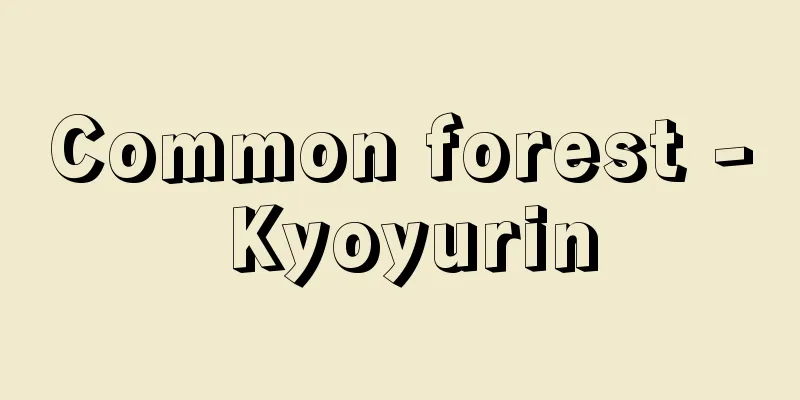Common forest - Kyoyurin

|
Legally, it refers to communal forest land shared by multiple people. Most of them originally came from muramochiyama (common mountain). Since the Meiji period, efforts have been made to nationalize muramochiyama or directly control municipalities through the division of public and private land ownership and the unification of public forest land consolidation project, and countermeasures have been taken, such as registered joint ownership under the names of the heads of households residing in the village. After that, internal factors such as changes in common use and external factors such as the policy to dismantle common rights have led to complex ownership forms and actual usage. While the practice of collective and communal use by village (settlement) residents remains, ownership forms include individuals, shrines and temples, joint ownership, groups, villages, and property districts (straddling private and public forests), and actual usage forms include those that retain the common practice (customary joint ownership) and those that are directly controlled by groups or divided individually. This is due to the difference in the stage at which common rights are dissolved, but since the Law Concerning the Promotion of Modernization of Rights Relating to Common Forests, etc. (abbreviated as the Common Forest Modernization Law) was enacted in 1966, the "modernization" of common forests (extinction of common rights and establishment and transfer of ownership, surface rights, etc.) has progressed, and the amount of common forests has been on the decline. However, there are still a considerable number of forests that are still subject to common practices (approximately 650,000 hectares as of the end of March 2011), and so rather than simply implementing a policy to dismantle common rights, it is necessary to encourage advanced, multifaceted use of the land for timber production, recreation, etc., in a way that is appropriate to the actual situation, based on the agreement of the rights holders. [Toshikuni Noguchi] [Reference] |Source: Shogakukan Encyclopedia Nipponica About Encyclopedia Nipponica Information | Legend |
|
法的には複数人が共有する共同利用林野をいう。多くは村持山(むらもちやま)(入会(いりあい)山)が源基形態である。明治以降、土地官民有区分、公有林野整理統一事業などで村持山の国有化ないしは市町村直轄化が図られていくのに対して、村落居住世帯主名を連ねた記名共有などの対抗策がとられた。その後、入会利用の変化などの内部要因および入会権解体政策などの外部要因によって複雑な所有形態と利用実態をもつに至った。部落(集落)住民の集団的・共同的利用の慣行を残しながら、所有形態としては、個人、社寺、共同、団体、村落、財産区などの形がみられ(私有林と公有林にまたがる)、利用実態としては、入会慣行を残したもの(慣行共有)と、集団による直轄化または個別分割化が図られているものとが存在する。これは入会権解体の段階差によるものであるが、1966年(昭和41)に「入会林野等に係る権利関係の近代化の助長に関する法律」(略称「入会林野近代化法」)が制定されて以降、入会林野の「近代化」(入会権の消滅と所有権、地上権等の権利の設定・移転)がすすめられ、入会林野は減少傾向にある。しかし、入会慣行を伴うものもまだ相当数(2011年3月末時点で約65万ヘクタール)残されており、単なる入会権解体政策ではなく、権利者の合意に基づき、実態に即した形で木材生産やレクリエーションなどの多面的な高度利用が図られる必要がある。 [野口俊邦] [参照項目] |出典 小学館 日本大百科全書(ニッポニカ)日本大百科全書(ニッポニカ)について 情報 | 凡例 |
>>: Covalent bond - Kyoyuuketsugou (English spelling) covalent bond
Recommend
Mā warā' al‐Nahr (English spelling)
The name given by the Arabs to the oasis settlemen...
Hammerhead shark - Hammerhead shark
A general term for the family and genera of the o...
Calligram
...The collection of essays from this period is C...
Ougishō - Ougishō
A theory on poetry from the late Heian period. Wri...
Gassho-zukuri
A form of Japanese architecture. A triangular sas...
Fuxin
A prefecture-level city in northwest Liaoning Pro...
al-Nuwayri (English spelling)
1279‐1332 He is one of the three great encyclopedi...
Brooke, L.
...After these artists, Helen Bannerman (1863-194...
Trochoid
…(6)When a curve Γ rolls on a constant curve C wi...
Clarke number
A number that expresses the average abundance of ...
Hokota [town] - Hokota
A former town in Kashima County, eastern Ibaraki P...
Leaf-cutter bee - Leaf-cutter bee
A general term for insects in the superfamily Anth...
Periwinkle (Periwinkle) - Periwinkle
A general term for snail shells in the family Litt...
Tilia kiusiana (English spelling)
…[Sumihiko Hatsushima]. … *Some of the terminolog...
Shirazi
...In addition, there are Arabs, Indians, and oth...









